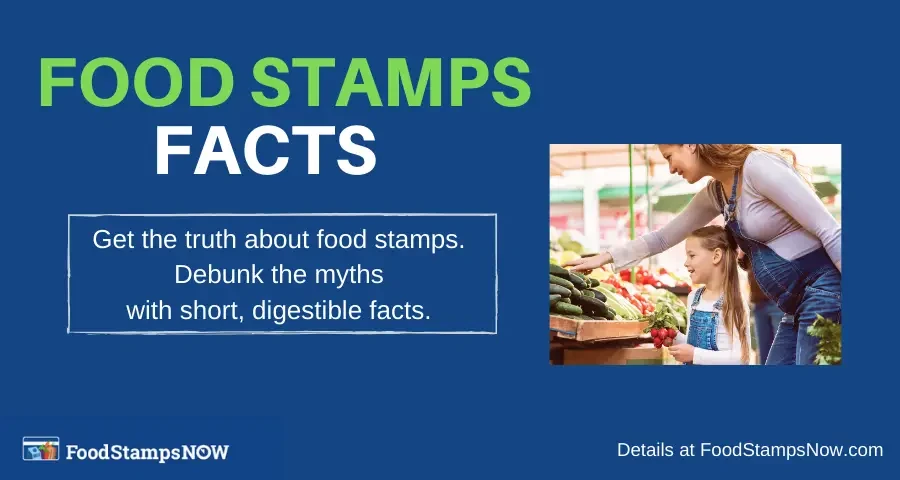There is a lot of disinformation about the food stamps program. Myths about the program reach more people than food stamps facts. This has created a stigma around this important program that provides access to nutrition for 36 million people.
This is frustrating for people on food stamps, who have to watch as a picture is painted of who they are and how they live that largely based on myths and not facts.
We decided it was necessary to set up a food stamps facts page to provide up to date, digestible facts about SNAP benefits and EBT.
Our plan is to continue to update this page with the most up-to-date facts we can find on food stamps and EBT to help set the record straight.

Food Stamps Facts
How many people use Food Stamps in the United States?
As of September 2019, 36 million persons were participating in the food stamps program.
What is the average food stamps benefit?
In 2019, the average food stamps beneficiary received a monthly benefit of $131.
What percent of the people who are eligible participate in the food stamps program?
The food stamps participation rate among all eligible persons was 85 percent in Fiscal Year 2016.
Participation rates for all eligible persons varied from state to state, ranging from a low of 56 percent to a high of 100 percent.
How much Does the Food Stamps Program Cost?
In 2018, the federal government spent $68 billion on food stamps program and other related food assistance programs. Here’s the breakdown of how the money was spent:
- 92% of the spending went directly to benefits that households used to purchase food
- 7% went to state administrative costs, including eligibility determinations, employment and training and nutrition education for SNAP households, and anti-fraud activities.
- Less than 1 percent went to federal administrative costs.
Food Stamps Income Limit
In most cases, your household must meet both the gross and net income limits described below or you are not eligible for SNAP and cannot receive benefits.
Gross income means a household’s total, non-excluded income, before any deductions have been made.
Net income means gross income minus allowable deductions.
A household with an elderly or disabled person only has to meet the net income limit.
| Household Size | Gross monthly income (130 percent of poverty) |
Net monthly income (100 percent of poverty) |
|---|---|---|
| 1 | $1,354 | $1,041 |
| 2 | $1,832 | $1,410 |
| 3 | $2,311 | $1,778 |
| 4 | $2,790 | $2,146 |
| 5 | $3,269 | $2,515 |
| 6 | $3,748 | $2,883 |
| 7 | $4,227 | $3,251 |
| 8 | $4,705 | $3,620 |
| Each additional member | +$479 | +$369 |
Food stamps income limits are higher in Alaska and Hawaii.
How Much Food Stamps Will I Recieve?
The dollar amount of benefits your household receives depends on the number of people in your household and your monthly net income.
It is based on a table determined by the USDA.
Below is the table showing how much food stamps you could receive if you are approved for benefits. The table is based on the number of people in a household.
Food Stamps Maximum Monthly Allotment Based on Household Size
| People in Household | Maximum Monthly Allotment |
|---|---|
| 1 | $194 |
| 2 | $355 |
| 3 | $509 |
| 4 | $646 |
| 5 | $768 |
| 6 | $921 |
| 7 | $1,018 |
| 8 | $1,164 |
| Each additional person | +$146 |
Benefit amounts are different in Alaska, Hawaii, Guam, and the U.S. Virgin Islands.
Food Stamps Recipients and Poverty
The food stamps program is heavily focused on the poor. About 92 percent of SNAP benefits go to households with incomes at or below the poverty line.
In addition, 55 percent go to households at or below half of the poverty line (about $10,390 for a family of three in 2019).
Who Gets Food Stamps?
Nationally, most of the people who receive food stamps are white. According to 2013 data from the U.S. Department of Agriculture, which administers the program:
- 40.2 percent of SNAP recipients are white
- 25.7 percent are black
- 10.3 percent are Hispanic
- 2.1 percent are Asian
- 1.2 percent are Native American
Do people on Food Stamps Work?
According to 2013 data provided by the USDA, 31% of food stamps recipients had earned income. Here is the breakdown of countable income of food stamps recipients by type.
- Earned Income – 31.2%
- Social Security – 23.6%
- SSI – 19.9%
- Zero Gross Income – 21.5%
- TANF – 6.5%
- General Assistance – 3.1%
Composition of Food Stamps Households
Most food stamps households include Children, Elderly or Disabled People. Here is a 2013 breakdown:
- Children – 44.8%
- Disabled nonelderly individuals – 20.3%
- Elderly Individuals – 17.4%
Out of the 36 million people receiving food stamps in 2019, only 2.9 million were able-bodied adults without depends (ABAWDs), that’s 8% of all food stamps recipients.
Food Stamps Facts Summary
We hope this post about Food Stamps facts was helpful to you. If you have questions about food stamps or EBT, please let us know in the comments section below.
Be sure to check out our food stamps questions and answers page, which answers the most frequently asked questions about food stamps and EBT.
